Entries by Megan Metcalf (113)
Please take action: Amtrak
Hey all,
Please take a second to write your congressperson about Bush's proposed 40% CUT in funding for Amtrak in 2009. Huh? Did he miss the news? The whole global warming, environmental thing? The rising costs of oil? The ugliness and pollution that cars bring? Oh yeah, he lives on some other planet or something. This is a copy of the letter I wrote, courtesy of Susan Och and the National Association of Railroad Passengers. Took about 10 minutes to find my congressman, customize, proofread, and send. I can't tell when they'll vote on it this year, but it looks like they've gotten to it in May or June in past years. Thanks!
----
Dear Congressman Rangel:
President Bush has only requested $800 million for Amtrak in his Fiscal 2009 budget. Please work to reject this 40% cut and fully fund Amtrak. America needs passenger rail now more than ever as gas prices rise, airlines shut down, and climate change gets closer to the crisis point.
Rail is an efficient, low carbon way to travel. In Europe and Asia, they are investing in high tech trains that can travel over 250 MPH. The US should at least maintain a 20th century level train system, and consider catching up with the rest of the world.
I also urge your support for the Passenger Rail Investment and Improvement Act, S. 294. The bill provides real, meaningful reform for Amtrak and a federal-state partnership for capital investments, which is enjoyed by the other modes of transportation. Please urge House leadership to pass companion legislation.
As you know, these issues are particularly critical to the citizens of New York State, a large portion of whom do not maintain personal vehicles. In addition to the day-to-day uses of the rail lines, train rides can provide a once-in-a-lifetime experience for cross country-travel: my parents just enjoyed our beautiful country by rail from San Diego to Seattle to Montana. They are looking forward to exploring the state of New York in the same way. Please continue to make this possible for future travelers.
Thank you very much for your leadership.
Sincerely,
Megan Metcalf
Eco-art in NYC (and online)
NYC folks, you have one more week to check out two great shows that address issues of sustainability with humor, verve, criticism, and great beauty.
Eyebeam's Feedback assembles an impressive array of projects engaged with sustainability and the environment in a big, dim, laboratory-like setting. Tech- and concept-heavy, the exhibits require some time to interact with explanatory texts and complicated diagrams. Artists, scientists, and designers explore themes like political engagement (an elegant call bank that connects directly with local and state politicians) and waste management (a piece called DrinkPeeDrinkDrinkPee - a little self-explanatory). I liked how the show itself expresses awareness about its conditions, lowering the lights to conserve energy and providing workshops, events, and additional resources to enable continued participation by visitors. Eyebeam, at 540 W. 21st, is open to the public Tuesday - Saturday, 12:00-6:00pm. Admission is free with a suggested donation. They are having a closing party next Saturday 19 April at 3pm.
On the next block, Adrian Piper's stunning Everything provides an abstract companion that kicks you squarely in the gut. The phrase "Everything will be taken away" appears in nearly every piece: over a mirror, the Bill of Rights, a gravestone-shaped hole in the gallery wall, the newspaper story of a gruesome kidnapping and rape, the photographs of Martin Luther King, Jr., JFK, Malcolm X, and others, and a garbage can full of trash. Her promise is both sinister and liberating, challenging us to consider the costs of freedom and asking if the erosion of freedom is something we have the power to halt.
What does this have to do with the environment? Moving clockwise from the door, the last piece -- the garbage can -- asks if human detritus can be taken away, who takes it away, how it gets taken away. It is a pointed critique about race and class, as most of Piper's work is, and echoes Van Jones' sentiments about how our disposable society considers humans disposable, too. Finally, the image points out that garbage of all kinds can be eliminated by choice or by force. These meanings radiated back through all of the work as I scanned the show again, and linked for me even more profoundly the relationship between politics, culture, and the environment. The gallery, Elizabeth Dee at 545 West 20th, is also open 10-6, Tuesday through Friday.
---
I know that some people who read my blog don't live in New York, so I'll provide these eco-art links as some payoff for reading the above rhapsodies:
This girl has been drawing everything she buys for the last couple of years. I wonder if she buys fewer things knowing that she'll be drawing it?
Chris Jordan's giant photos in Running the Numbers contain lots of little things and big political messages.
Water bottles and shopping bags
Much has been said about the most visible of "green" lifestyle changes, the water bottle, and I thought I'd add my two cents. I bought about five bottles of water in 2007; if I had to guess, I'd say I bought ten the year before. Specifically, I thought people at my art opening last July might want to drink water (they preferred the whiskey), and I was pretty much forced into buying a bottle at a crowded take-away place when I asked for a cup of tap water. Three of these purchased bottles are still in my fridge, unopened. I started Fix with approximately twenty taking up space on the top shelf: the plastic devils have a way of showing up and hanging around. It seems like I'm always being handed one on the street, drinking only half at a meeting -- not to mention the several provided every airplane flight. I take 'em home, drink the contents, fill 'em up with tap water, and repeat. Over and over, with some washes in there. When they get funky, I put them in the recycle. So I think it's really funny when long eco-blog conversations get started about the benefits of one trendy refillable over another. I read a good one on Brave New Leaf a few weeks ago. Sure, my bottles will eventually run out - I do refuse them quite often - and then I'll have to choose between the Sigg (pictured), the Klean Kanteen, or the tried-and-true but now vilified Nalgene. Before I buy one of those, though, I'll give No Impact Man's solution a try: a glass jar with a lid. Got plenty of those hanging around.
Got plenty of bags for shopping hanging around, too. Paper bags, bodega bags, plastic bags -- they have babies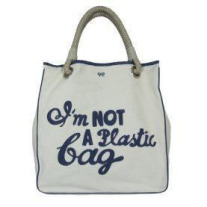 when I'm not looking, I swear. The cloth ones are a little less promiscuous, but I still have a ton of them: free totes from benefits, worn messenger bags and backpacks from college, a gigantic beach bag I got as a gift. I can't imagine actually buying a special bag for shopping, when I have so many taking up precious inches in my apartment. The plastic bags are the best: they take up virtually no space in the bag I'm already carrying for the day and I can reuse them over and over again. When they get worn out, I demote them to bags for garbage or compost, but this takes a long time. I guess my point is, though I'm grateful for how reusable bottles and bags have become visible symbols of personal environmental "action," they are still consumables. It will take us so long to make our way through the manufactured things already in circulation, I don't see a whole lot of logic in pouring precious resources (oil) into things we already have.
when I'm not looking, I swear. The cloth ones are a little less promiscuous, but I still have a ton of them: free totes from benefits, worn messenger bags and backpacks from college, a gigantic beach bag I got as a gift. I can't imagine actually buying a special bag for shopping, when I have so many taking up precious inches in my apartment. The plastic bags are the best: they take up virtually no space in the bag I'm already carrying for the day and I can reuse them over and over again. When they get worn out, I demote them to bags for garbage or compost, but this takes a long time. I guess my point is, though I'm grateful for how reusable bottles and bags have become visible symbols of personal environmental "action," they are still consumables. It will take us so long to make our way through the manufactured things already in circulation, I don't see a whole lot of logic in pouring precious resources (oil) into things we already have.
Typical post-Fix scenario
When Fix ended and I started buying stuff again, I approached consuming with a new perspective. The research I did during Fix made it clear how resource-intensive new things are, and I still believe that buying less stuff, via repairing old things, buying used, borrowing, renting, or simply deciding you don't need something, is one of the most environmentally friendly lifestyle changes one can make. At the same time, I've had a little more money to upgrade the products I surround myself with to ones that are made better and I can repair with more success; I also feel it's my responsibility to buy things that are made more sustainably because I can, hopefully proving the viability of these models and therefore lowering the price in the long run. (With the current economy, who knows if this will ever happen...)
Recently I embarked on buying a new razor. I wasn't entirely happy with the Preserve razor I purchased at a premium last year, so I thought I might follow a fellow eco-blogger's advice to try a safety razor. She bought hers used on e-Bay. (This may seem gross but there are sites devoted to teaching you how to clean it and replace the blade so it's safe for shaving today.) I thought this was a good idea, preferring the used option for most things these days - books, clothes, paper, etc. I spent a good hour researching the recommended kinds and then another hour researching where to get them online. e-Bay had a model that seemed right, a year old, at 2/3 the price of a new razor. I bid, and another zealous buyer had set a price higher than mine, so the price kept going up and up. At a certain point, the used price started to seem ridiculous - the same as a new one! I know a new razor costs more to produce than a used one; at the same time, the e-Bay razor will have been packaged and shipped at least twice. Plus, I'd have to buy a special soap to clean it, which will have its own packaging and shipping. Finally, the idea is that I will use this razor for the rest of my life but is this really true? What if it's a total hassle? I will have purchased a razor and blades for a substantial amount of money and resources...I suppose I could always sell it again on e-Bay...
The point of all of this is that I've spent now at least two and a half hours on this razor, which seems like a lot of time to spend on a product. I'd rather spend two and a half hours researching a trip to Greece, or - more to the point - my time might be better spent on the phone with 311 about the recycling (again), volunteering at a soup kitchen or local tutoring center, or writing my congresspeople, city councilmembers, and state senators about the NYC e-waste and congestion pricing bills. In short, some of this "environmental action" feels a little like throwing the baby out with the bathwater. All this energy could be spent in more eco-productive ways. And I still don't have a new razor.
I'll leave you with another example, one that feels a little less futile than the razor but illustrates why I think a lot of people just shut their brains off about this stuff. I was in the store buying mints. They didn't have the kind I usually buy, so I tried to evaluate the rest of the options. There were a bunch made by huge companies, rolls wrapped in foil, i.e.: not a lot of packaging per mint. There was another organic kind in a metal tin; at the time, I figured the tin could probably be recycled with the metal, and at the very least re-used for something like paper clips or buttons or something. So I bought those, at a considerable cost. But later, as I pull mints from the tin, I think to myself, "I already have a little box for paper clips and buttons." And when I move, I'll probably come across the empty mint tin and think, "I'm not gonnna drag this thing to another state!" And then I'll throw it out - I'm sure the NYC recycling people only recycle metal in the shape of a can.
Tidbits
A coupla little things for this week:
My friend, an occupational therapist, has designed a lifestyle modification course for USC faculty and students with the environment as a focus. She sent me this article, which explains how she's teaching people how to choose the lesser of environmental evils - or the better of goods - like when to pick local produce over organic, for example. If you had 8 tips to share with the most earth-unfriendly people you know, what would they be?
I went to a concert this week that was produced with Reverb, a company that is "greening" concert tours by offsetting carbon footprints, offering eco-literature, and promoting recycling. (Is there anything that can't be greened these days?) Their 2008 list looks a little sparse - maybe you can get the word out in one of the fan clubs you belong to...? Do you think Reverb's trouble is worth the effort?
Finally, if you haven't yet heeded my command to read Kunstler's Long Emergency (ahem), now you can watch the movie, A Crude Awakening: The Oil Crash. It's not Kunstler's movie, but it's got the same themes and warnings. Compelling watching, with great archival footage -- and it sparked a good debate between friends about whether freaking people out is a useful strategy for eliciting the change we need. This movie makes the argument that if more people knew what we are up against in the coming years, more corporations and governements would be working day and night to find real solutions. Share it with at least 10 friends.
More on recycling
I thought you might find this email exchange amusing...
-----Original Message-----
From: megan metcalf
Sent: Monday, February 25, 2008 2:07 PM
To: Building Management
Subject: Garbage/Recycling: E. 117th
Hi, Manager -
I'm wondering if there's a problem with the garbage at E. 117th? It looks like it hasn't been taken out in weeks: there is a pile to the side of the building that is several bags high and several bags deep. Not only is it disturbing, it makes the stairwell smell and I'm sure it's not helping with the rats and roaches. I hope this will be taken care of right away - I thought the garbage is picked up Monday; I hope we won't have to wait until Thursday.
Also, I thought I'd paste what I found on the DSNY website about recycling here:
"Buildings with ten or more apartments that receive four or more Notices of Violation within a six-month period will be fined $500 for each bag that violates recycling regulations, up to a maximum of 20 bags within a 24-hour period. This translates to a maximum fine of $10,000 per day."
I know New York's recycling rules have been confusing in recent years - I'm sure you're working on getting a functional recycling system together for our building as soon as possible.
Thank you!!
Megan Metcalf
Manager <Manager@dawnaydayusa.com> wrote:
Let me also try to explain how the recycling system works. In order for a system to work everyone has to participate in the system. As you probably notice there may not be any signs posted. That's because each time they are someone tears them down. Also even if the signs remain tenants are not cooperating with recycling anyway. Recycling doesn't just start when you throw the garbage out it starts in your apartment when you separate your garbage before you bring it downstairs.
Now whether or not signs are posted or actual cans are displayed it still does not prevent anyone from bringing down their plastic and bottles in the light blue clear bags. Nor does it stop tenants from tying up old magazines or books before they throw them out. Tenants have to also do their share as well as management.
I do believe that we are presently awaiting the appropriate cans for the correct disposal of everything. Now once they have arrived and everything is set up let's see the tenant participation.
Date: Tue, 26 Feb 2008 07:09:57 -0800 (PST)
From: "megan metcalf"
Subject: RE: Garbage/Recycling: E. 117th
To: "Manager" <Manager@dawnaydayusa.com>
No problem! I've been separating my recycling and taking it on the subway to work, where they recycle. It sometimes gets heavy, though, and they are not so happy with this arrangement. I don't have enough on my own to fill up a clear or blue bag.
I'm so glad to hear about the new cans - I'm sure you're also planning on making the garbage area to the side of the building cleaner and safer, which is probably why people don't go down there. It isn't well lit, there are bugs and rats around, and people not from the building sometimes hang out down there. I'm sure you're aware that my upstairs neighbor was held up at gunpoint in the lobby two weeks ago.
Thanks again for all of your help!
Megan Metcalf
---
Nope, I haven't heard anything since...and, nope, no recycling bins have shown up either. The trash was thankfully thrown away the same day I sent the email - not sure what was going on with that.
New York: easy to love, easy to hate - still here after 10 years!
Food rescue
Last weekend -- perhaps to offset the insane amount of food waste we generate at breakfast and lunch -- my office organized a volunteer opportunity with the Food Bank for New York City. Basically what the Food Bank does is take gigantic donations of food and re-distributes it to hunger programs in the five boroughs. They operate out of an industrial warehouse at the Hunt's Point market in the Bronx. I was super-excited because individuals can't volunteer on their own - they get referred to a partner soup kitchen, homeless shelter, school, etc. While these programs are vital, the Food Bank interests me in particular because of its emphasis on efficiency of resources and reduction of waste.
My coworkers and I were tasked with re-packaging food that had been donated through some of its smaller sources: can drives at schools and workplaces and, surprisingly, Target. If a box of cereal gets run over by a shopping cart or a curious kid damages the packaging of something, the product gets pulled from the shelf; most of the time, these perfectly useful and edible things go into the trash. This thoughtful Target (I don't know which one) dumps them all in boxes and sends them to the Food Bank. (They probably get a tax write-off, too.)
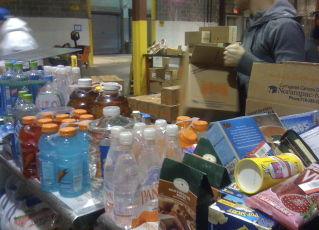 We were sorting the items by category: fruits, vegetables, household products, personal care, beverages, snacks, etc., and creating boxes of a particular weight, determined by what was inside it. The Food Bank gave us detailed handouts about dented cans and expiration dates: some of the items had to be discarded after their expiration dates, others they have guidelines written by a nutritionist on how long past the date is acceptable to pass the donations along. The items that didn't pass our tests had to go in a big orange trash bin.
We were sorting the items by category: fruits, vegetables, household products, personal care, beverages, snacks, etc., and creating boxes of a particular weight, determined by what was inside it. The Food Bank gave us detailed handouts about dented cans and expiration dates: some of the items had to be discarded after their expiration dates, others they have guidelines written by a nutritionist on how long past the date is acceptable to pass the donations along. The items that didn't pass our tests had to go in a big orange trash bin.
The whole thing was incredibly eye-opening, for a number of reasons. I was astonished at how many things were donated that were way past their expiration dates - this box of muffin mix looks like an antique! 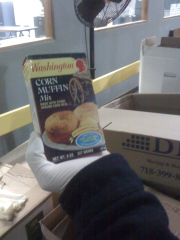 It's great that people open their cabinets during food drives, but I think they forget that actual people are supposed to end up with this stuff. I was also heartbroken every time something went into the trash: I would estimate that 10% of the stuff we sorted ended up in the bin. Maybe 1% of that amount I wouldn't have eaten, faced with the same dilemma at home. Now, I know that I've done some stuff this year that people would label gross by conventional standards - using hankies, not flushing every single time, collecting my food scraps in the fridge for compost. But this stuff was only marginally gross: boxes of things slightly past their expiration, stale cookies, juice with the label ripped off. It killed me to see it tossed - yes, that's water in the bin below (I think the bottle was too misshapen to pass along) - and I know that the Food Bank can't compromise its reputation for this lowly 10%. I asked one of the regular employees if any local homeless people had figured out that the Food Bank bins were full of food. He said he knew some people had been in them before, but they were kind of difficult to get to and it didn't happen very often. The market is geographically isolated, surrounded by gates, high fences, and barbed wire - I doubt too many scavengers make it in.
It's great that people open their cabinets during food drives, but I think they forget that actual people are supposed to end up with this stuff. I was also heartbroken every time something went into the trash: I would estimate that 10% of the stuff we sorted ended up in the bin. Maybe 1% of that amount I wouldn't have eaten, faced with the same dilemma at home. Now, I know that I've done some stuff this year that people would label gross by conventional standards - using hankies, not flushing every single time, collecting my food scraps in the fridge for compost. But this stuff was only marginally gross: boxes of things slightly past their expiration, stale cookies, juice with the label ripped off. It killed me to see it tossed - yes, that's water in the bin below (I think the bottle was too misshapen to pass along) - and I know that the Food Bank can't compromise its reputation for this lowly 10%. I asked one of the regular employees if any local homeless people had figured out that the Food Bank bins were full of food. He said he knew some people had been in them before, but they were kind of difficult to get to and it didn't happen very often. The market is geographically isolated, surrounded by gates, high fences, and barbed wire - I doubt too many scavengers make it in.
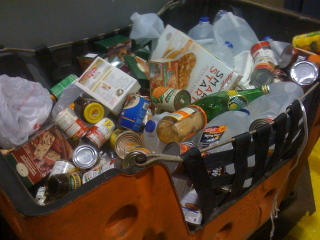 The thing that really got me worked up, though, was what was passing for "food" for needy New Yorkers. For every box of Cheerios we put in the 'cereals' pile, we put at least 3 or 4 boxes of Frosted Flakes, Lucky Charms, or some other sweetened cardboard. Target was happy to pass along cases and cases of green- and red-wrapped chocolates for the holidays, once they had gotten all their mileage out of the half-price sale. They passed along hundreds of pounds of boxes of holiday cookies and cake mix, and even gummy worms and candy vampire teeth from Halloween. It makes me sad that this stuff is marketed and accepted as "food" in America; when I think about it as the only thing available to feed people who actually need nourishment, I start to feel a little sick. By my estimates, we boxed nine or ten 30-pound boxes of vegetables (canned), maybe seven or eight of fruit, and ten or fifteen 25-pound boxes of 'protein' (tuna fish and the like). On the other hand, we packed at least two pallets of beverages (stuff like no-calorie flavored soda) and eight full pallets of 'snacks' -- that's 512 ten-pound boxes of sugary, salty crap!
The thing that really got me worked up, though, was what was passing for "food" for needy New Yorkers. For every box of Cheerios we put in the 'cereals' pile, we put at least 3 or 4 boxes of Frosted Flakes, Lucky Charms, or some other sweetened cardboard. Target was happy to pass along cases and cases of green- and red-wrapped chocolates for the holidays, once they had gotten all their mileage out of the half-price sale. They passed along hundreds of pounds of boxes of holiday cookies and cake mix, and even gummy worms and candy vampire teeth from Halloween. It makes me sad that this stuff is marketed and accepted as "food" in America; when I think about it as the only thing available to feed people who actually need nourishment, I start to feel a little sick. By my estimates, we boxed nine or ten 30-pound boxes of vegetables (canned), maybe seven or eight of fruit, and ten or fifteen 25-pound boxes of 'protein' (tuna fish and the like). On the other hand, we packed at least two pallets of beverages (stuff like no-calorie flavored soda) and eight full pallets of 'snacks' -- that's 512 ten-pound boxes of sugary, salty crap!
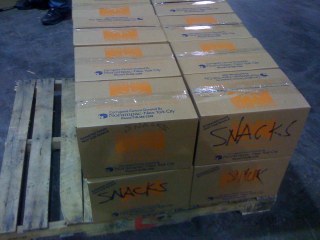 With a sick feeling in my stomach, I asked one of the workers if this was all that was available to the hunger programs. He assured me that these boxes are extras that get added to an order: the majority of their donations come in huge quantities straight from suppliers - things like rice, canned vegetables, cases of cereal, etc. He took me into their bigger warehouse and showed me how everything gets inventoried so their constituent programs can see what's available in real time. They add the boxes of stuff we packed up to the order, based on the size of the order.
With a sick feeling in my stomach, I asked one of the workers if this was all that was available to the hunger programs. He assured me that these boxes are extras that get added to an order: the majority of their donations come in huge quantities straight from suppliers - things like rice, canned vegetables, cases of cereal, etc. He took me into their bigger warehouse and showed me how everything gets inventoried so their constituent programs can see what's available in real time. They add the boxes of stuff we packed up to the order, based on the size of the order.
Which leads me to my final point. I'm sure that the Food Bank needs our hands and eyes for sorting. But what they really need is our money and our awareness. They repeated several times the statistic that 1.3 million New Yorkers rely on emergency food programs - I had no idea that such a large percentage of the city needs this type of assistance, and, with food and fuel prices going up, I'm sure the problem continues to grow. This day was no miracle, but I hope a few more people understand what food means in the city and around the country. Perhaps by this blog maybe even a couple more. Jonathan Bloom, author of Wasted Food, is also doing a great job investigating the problem - I can't wait for his book to come out!
Good piece of propaganda
I've watched a bunch of documentaries about the corporatization of contemporary society, the transformations of our food systems, and unfair labor practices around the world. They are all similar in tone and production values, and I view them with the understanding that the filmmakers have a very strong agenda they just need to get out there. I watched one recently, though, that stands out as more nuanced and thought-provoking than most: Wal-Mart: The High Cost of Low Price. I went into it thinking I would see a film about sweatshops and the squashing of local businesses, but it also hits hard on discrimination in the workplace, substandard health insurance for the lowest wage-earners in America, anti-unionization efforts, and the failure to provide for the safety of customers. In light of my other recent recommendation, James Howard Kunstler's Long Emergency, the movie's evidence is particularly poignant.
...the destruction [corporations] wreaked was as manifest in the ravaged towns of Ohio and upstate New York as in the environmental degradation of China...In effect, the American heartland was overtaken by a new kind of corporate colonialism, emanating from our own culture, but no less destructive than the imposition of foreign rule.
Americans failed to recognize the essential fraudulence of the idea that this destruction was 'creative' and would lead to a higher good--in other words, the end justified the means, even as they watched their towns die around them. Corporations such as Wal-Mart and its imitators used their wealth and muscle to set up 'superstores' on the cheap land frontier outside small towns and put every other retail merchant out of business, often destroying most of the town's middle class. They also, incidentally, destroyed the local capacity to produce goods. And the American public went along with it for the greater good of paying a few dollars less for a hair dryer. (The Long Emergency, 189)
Check them both out ASAP - I got the movie on Netflix. I've been to Wal-Mart twice in my life and will avoid it at all costs in the future. I don't live in a place where Wal-Mart is an option; in most places, it is the only option for certain basic needs - for that and for your community, I am very, very sorry.
Clothes!
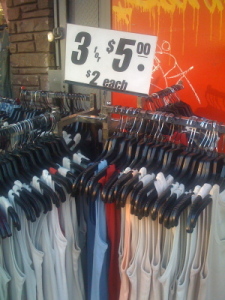 Those of you keeping track will notice that a good quarter of the things I've purchased in 08 have been clothes. Frankly, I've done more shopping in the last two months than I did in the previous two years. I'm shocked that it's managed to keep my interest -- I guess the research-project aspect of it and more money to spend have made it tolerable. There's a huge spectrum of options out there, ranging from sweatshop-tastic to mittens made from pampered bunnies hand-combed to yield a special angora. I thought I'd report back, and pose some questions to the people out there challenged by similar issues.
Those of you keeping track will notice that a good quarter of the things I've purchased in 08 have been clothes. Frankly, I've done more shopping in the last two months than I did in the previous two years. I'm shocked that it's managed to keep my interest -- I guess the research-project aspect of it and more money to spend have made it tolerable. There's a huge spectrum of options out there, ranging from sweatshop-tastic to mittens made from pampered bunnies hand-combed to yield a special angora. I thought I'd report back, and pose some questions to the people out there challenged by similar issues.
At the "worst for the environment and for people" end of things, I finally went to H&M to redeem the gift certificates I received last summer. I didn't actually spend any of my money though I did articulate the opinion that cheap throwaway clothes - jeans and a work shirt - are something people want. I noticed one shirt in the store that was made of organic cotton, a step in the right direction, but I didn't need it for anything and it was ugly besides. I have a couple more certificates that I will use, and then I will try to say goodbye to H&M forever. It's been a mainstay for basics and things that don't get heavy use, like work clothes.
I also went into Old Navy to look for some T-shirts that a friend recommended. They didn't have a single one in my size, so I cruised over to the clearance table. $2.99 for a long-sleeved tee! Wow! -- But wait, it's a funny color. -- But it's only $2.99! And it looks really cozy! -- "Made in El Salvador." 'Made in Vietnam." "Made in Cambodia." -- I started to feel a little sick: this shirt definitely didn't cost $2.99. I know it's just a little 8oz shirt but I'm sure there's a fuel cost -- and packaging costs and equipment costs and the costs of paying the Old Navy workers, not to mention the amount the Vietnamese factory worker SHOULD be getting. Increasingly freaked, I just walked out of the store.
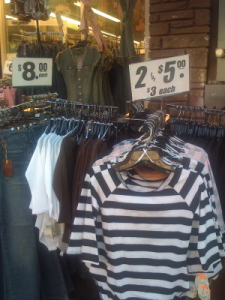 I still need t-shirts. The ones I bought a couple of years ago are worn out completely. Not only do they have to be the right size, have the right feel, the right weight, the right colors, it would be great if they could be made locally of organic cotton in a certified fair-trade environment. But I don't think they have local organic fair-trade t-shirts. So I have to pick one or some of these criteria. I will probably be able to afford a couple American Apparel shirts (sweatshop free?), but their organic selection is very small. I don't know of any major retailer who is making basic organic cotton t-shirts that I can try on somewhere. Most of the organic clothes places I've found make stuff that seems pretty coarse and hippie-ish. Let me know if you have any ideas.
I still need t-shirts. The ones I bought a couple of years ago are worn out completely. Not only do they have to be the right size, have the right feel, the right weight, the right colors, it would be great if they could be made locally of organic cotton in a certified fair-trade environment. But I don't think they have local organic fair-trade t-shirts. So I have to pick one or some of these criteria. I will probably be able to afford a couple American Apparel shirts (sweatshop free?), but their organic selection is very small. I don't know of any major retailer who is making basic organic cotton t-shirts that I can try on somewhere. Most of the organic clothes places I've found make stuff that seems pretty coarse and hippie-ish. Let me know if you have any ideas.
The closest I got to local clothing was buying some stuff from a couple of New York designers that I really like. They're not still small enough to be manufacturing the stuff by hand in the shop, like when they started, but they are both quite involved in the production and sales of their designs. Meg, one of them, told me how she's trying to move her Pakistani fabricating shop into the same building as the store -- she's been working with the same guy for 15 years. As her business has grown, she has expanded to factories in Canada, Asia, and the Middle East; she told me she's visited every one. It was fun chatting with her about this: I felt a little like I do at the farmer's market.
I also had fun trying some stuff from Nau, a new company that is trying to be both fashionable and sustainable. They use exclusively renewable materials and sustainable processes and describe their sources on their site; I was also impressed by how little packaging the stuff arrived in - just a small envelope made of recycled paper. The cost of these wonderful things is normally beyond my reach; I am looking forward to their New York sale March 6-9. Finally, I bought a pair of shoes for work and for fun; not explicitly "sustainable," they seem to be of high-quality materials and made to be repaired. Shortly afterward, I found this company online: I will look forward to checking out the Terra Plana store in New York when I need shoes again.
I should be clear that I don't think products are the answer to our environmental and social problems. I think as a culture we buy and throw away too many things that we never used and never needed. Of course the things we do need - t-shirts, shoes, toilet paper - must be produced in better ways or soon enough they won't be produced at all. We'll be digging them out of old landfills. With that in mind, at the end of all of this shopping, I went to another clothing swap, the most fun way to get new clothes.

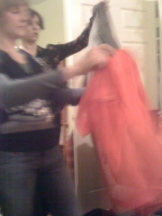

The shopping I did was really shopping: that is, I looked at labels and asked questions and tested things out and compared items. It's time-consuming and things aren't so transparent. At the end of it all, it became even clearer to me that buying used or refashioning something old is the most people- and earth-friendly way to go for a new getup. Still, it's really nice to have something fresh and new every once in a while.
Things that will stick
Handkerchiefs and the library. Seriously. I tried a lot of things last year, and some of them I will probably continue for a long time. But these two I can be sure of.
I started with the handkerchief thing because I knew I would run out of tissues and I was afraid I would run out of toilet paper. I really didn’t want to have to use cloth at the end of 07 – my apartment is small and laundry is not so easy. I asked my grandmother if we could make some handkerchiefs when we had our sewing visit last year; she suggested instead that she give me a stack of old men’s cotton hankies. Perfect! They are soft on the nose and less gross than it might seem. Plus, having a hankie in your bag is great for many things: spilled coffee, a forgotten napkin, etc.
As the daughter of a librarian and a big reader, you’d think the public library would be a no-brainer. But the New York system seemed like all of the other crazy city bureaucracies and since college I’d gotten in the habit of writing in my books and thinking I’d need to go back to them. So I’d been buying books new! Not very often and not very many, but this was a practice I clearly didn’t need to engage in.
Last year I started exploring the options with the NYPL: there is a branch not too far from my house, but even better, there is a tiny branch right by work. I realized that I can’t approach them like bookstores, browsing like I did as a kid, but rather like my mailbox for Netflix. Anytime someone recommends something to me, I put it on my library list online. If 221 other people are waiting for it, I’m sure there’s something else I can read in the meantime, or, I can assess other options, like seeing if a friend has it or buying it used. Eventually my request turns up at the library I choose, and they conveniently send me an email letting me know it’s there. They’ll even hold it for a few weeks if I can’t get to it right away. This little system is so perfect: I’ve read some things that I decided I needed to own, so I bought them used without a second thought.
Not just for my mom’s sake, I have to push this one: please, please, please support your public library, one of the most democratic and First Amendment-positive institutions we have going. It turned out to be way easier than I thought it would be; if I can do it in New York City, you can too.
